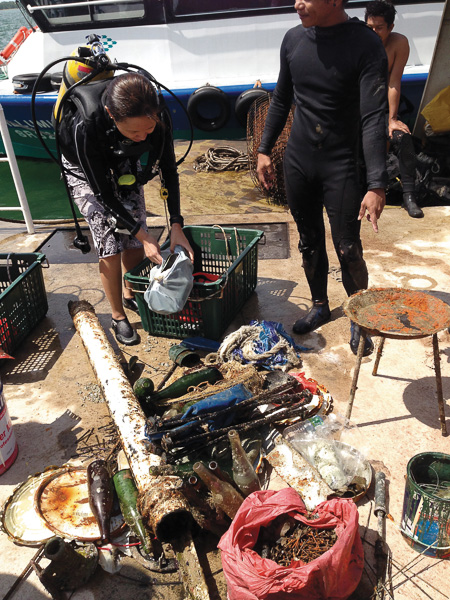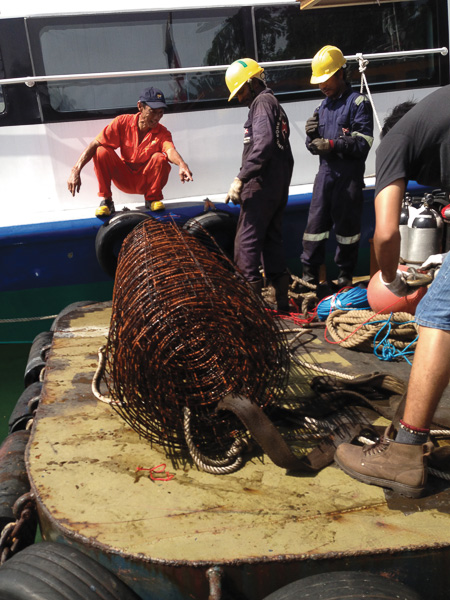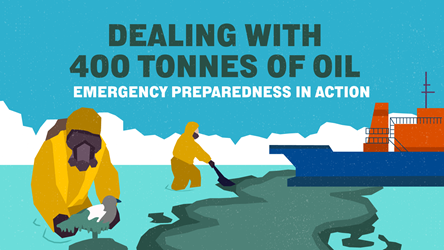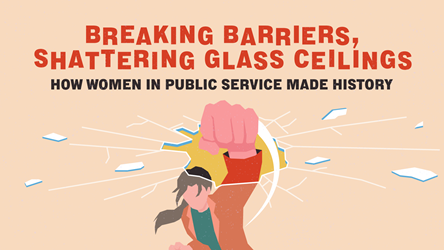Collaborating to Save the Reefs of Pulau Hantu
Nearly four metres in length and a metre in diameter, the steel reinforcement bar, or rebar, weighed heavily on the coral reefs of Pulau Hantu (Ghost Island in Malay). Nearby, numerous paint buckets and bottles of turpentine lay side by side, as well as bolts, nuts and nails that had begun to rust. The water was cloudy with spilled paint while handles of red plastic bags waved enticingly to unsuspecting sea life.
This was the depressing sight that greeted divers in July 2013 during a leisure dive with Hantu Blog, a non-profit, volunteer-run dive organisation whose mission is to safeguard Singapore’s natural marine heritage.
Because of the weight and quantity of the debris found, and without the necessary equipment to clear it up, the divers had no choice but to only take pictures of the rubbish, before leaving the reefs.
As Hantu Blog is a prominent member of Singapore’s marine conservation circles, its volunteers are regularly invited to attend sharing sessions by the Maritime and Port Authority of Singapore (MPA). Through these, we learned about the stringent measures put in place by MPA against indiscriminate dumping. So we knew that the best thing to do was to alert MPA about the debris.
We sent a brief email to MPA’s Manager of Community Engagement detailing what we had observed on the reefs, together with the photographs taken.
Within an hour, we received a reply from Mr Lam Yi Young, MPA’s then Chief Executive. It was just three sentences long, but those concise sentences expressed thanks, described an intention to identify the vessel responsible for the alleged dumping, and stated a desire to collaborate to retrieve the submerged debris.


The words, though simple, were not empty. The following day, MPA invited Hantu Blog to revisit Pulau Hantu on board their survey vessel, Discovery. This was a unique opportunity for not only Hantu Blog but also the public, through the blog’s multiple online and social media platforms, to understand and witness first-hand the work that MPA does on a daily basis to maintain our waterways.
With the help of a multi-beam sonar, cartographers, engineers, and extremely skilled skippers to nimbly manoeuvre the state-of-the-art vessel close to the shallow reef, MPA collected first-hand data of the debris and pinpointed its exact location without dipping a toe into the water.
It was an eye-opener for MPA staff to learn about the work of Hantu Blog as well. Despite their hours spent at sea, they do not get to witness the reefs the way we do. To our pleasant surprise, every member of the MPA crew had a print-out of the initial details and photos from Hantu Blog that had been sent to MPA. As some of the photos included sightings of marine life, the engineers were curious and surprised to learn about sea snakes, sea turtles and sharks that can be encountered at Pulau Hantu’s reefs!
The last thing anyone wanted, was for the rebar removal process to cause further reef damage. Corals, which are colonies of animals that not only live on but build our reefs, are like large trees in the forest – once destroyed, they can be difficult, if not impossible, to replace as they are also a habitat for a myriad of other marine creatures. Besides, the rebar, which was quite close to the surface, could also pose a hazard to docking vessels. Hence it had to be moved. But how and with the least environmental impact?
To get an answer, MPA tapped the experience of marine biologists at the National Parks Board (NParks). Hantu Blog also participated in discussions. Finally, the marine salvaging experts who were engaged for the job chose a method that would have no visible impact on the reefs, based on our combined discussions.



Six days after the incident was brought to the attention to MPA, Hantu Blog was back at Pulau Hantu, on board another MPA vessel to dive into the reefs with the salvaging experts to observe and assist with the removal of the debris.
Staff from Sentosa Development Corporation (SDC), which oversees the management of Pulau Hantu and the nearby Southern Islands, were also on board. Volunteer scientists from the Raffles Museum of Biodiversity Research and Blue Water Volunteers as well were invited by Hantu Blog and welcomed by MPA.
The experts finally extricated the massive rebar with a float bag to minimise impact on the reefs.
Throughout the entire process, the needs and concerns of all stakeholders were taken into consideration, and with careful management and communication, all stakeholders benefited from the collaboration and participation.
Two months later, Hantu Blog received an email from MPA, closing the loop to their investigation into the debris at Pulau Hantu. A contractor hired by SDC had been doing maintenance work on Pulau Hantu when the materials, while being transported between the island and their vessel, fell into the sea by accident. Workers said they were unable to retrieve the items and did not report the incident to their bosses or SDC.
As a result, the contractor agreed to bear the cost of the salvage operation, and MPA took enforcement action against the contractor for failing to inform the Port Master of the incident without delay.
This experience establishes how it is possible for there to be mutual benefit when institutions engage with and involve interest groups as effectively as MPA had in this incident.
As shown, the process allowed MPA to tap our resources and knowledge, which we were happy and most willing to share. MPA itself also shared with us their knowledge, and showed us how they plan, study and maintain our ocean fairways. Through this, we got to witness and learn about what MPA does. The better we understand their position, the better we can make a positive contribution to complement their work.
Debby Ng is founder and volunteer with Hantu Blog (www.pulauhantu.org), a volunteer-run organisation dedicated to developing public awareness about Singapore’s coral reefs and encouraging participation to safeguard them. The blog organises regular public tours for divers to the island. Ms Ng is available for invitation to corporate, school and public talks.
- POSTED ON
Mar 7, 2014
- TEXT BY
Debby Ng









